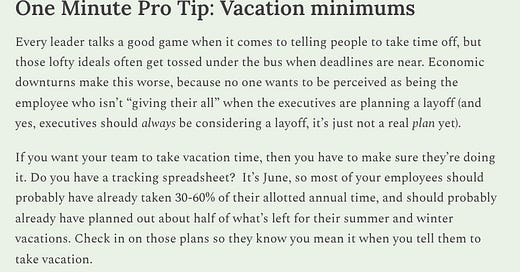The Value of Safety
What we value isn't just what we talk about. It's how we get in our own way to demonstrate a value.
Leadership Moment: Is this really about safety?
Every season, the NFL tweaks its rules. Two notable changes this season stand out: a modification to Thursday night games to let the NFL “flex” games into a Thursday in the midseason, and allowing fair catches on kickoffs, with the ball placed at the 25. What do these rules have in common? Money.
Both changes are consistent with a clear NFL objective: maximizing eyeballs for advertisers. Thursday games are generally believed by fans to be bad games. Sometimes this is schedule luck: teams that looked good on paper in April may be awful by October. It may also be an intrinsic problem: a team that played on Sunday doesn’t have the time to install as complex (and interesting) a game plan for a game on Thursday, while minor injuries haven’t had a chance to heal. Fans don’t engage as heavily with Thursday night games, and that may put broadcast rights at risk of lower revenue in the future.
What does that have to do with kickoff returns? The majority of kickoffs are currently non-plays. Teams kick the ball through the end zone for a touchback, putting the ball on the 25 yard line. A handful of teams instead aim to kick the ball high and just short of the goal line, forcing a return play. But are casual fans at home watching those plays? After a touchdown, there is often a brief commercial break, then a point-after try, then a long commercial break, then a kickoff, and then another brief commercial break, and then play resumes. Fans taking that opportunity for a long bio break are missing out on the opportunity to be advertised to.
Ostensibly, though, the kickoff change is about safety. Special teams plays have a slightly higher risk of injury*, and the NFL is all about safety for its players, right? It’s hard to reconcile that assertion with the new Thursday rule. Thursday games are more dangerous* for players, and adding in more games being moved around onto Thursdays, with surprising schedules, is inconsistent with a stated NFL value of player safety.
Matthew Slater of the New England Patriots calls the NFL out: "I just don't believe this is truly in the name of player health and safety. What I do believe is, 'We want to portray ourselves a certain way to the public that says we care about the players.'" That’s a common risk when organizations justify moves that are aligned with their bottom line as being driven by a corporate value, when that value is mostly ignored when it’s inconvenient to management.
*The data on both of these statistics is hard to interpret, and there are a lot of different ways to analyze injury risk, so I’m not cherrypicking specific studies. You can believe my handwaving or try to read through all the analysis online yourself.
One Minute Pro Tip: Vacation minimums
Every leader talks a good game when it comes to telling people to take time off, but those lofty ideals often get tossed under the bus when deadlines are near. Economic downturns make this worse, because no one wants to be perceived as being the employee who isn’t “giving their all” when the executives are planning a layoff (and yes, executives should always be considering a layoff, it’s just not a real plan yet).
If you want your team to take vacation time, then you have to make sure they’re doing it. Do you have a tracking spreadsheet? It’s June, so most of your employees should probably have already taken 30-60% of their allotted annual time, and should probably already have planned out about half of what’s left for their summer and winter vacations. Check in on those plans so they know you mean it when you tell them to take vacation.
Upcoming Appearances
June 9: Talk, Building your leadership practice, RMISC, Denver, CO
June 14: Keynote & book signing, RVASec, Richmond, VA
June 15: SANS Executive Roundtable, The CISO’s Guide to Managing Cloud Security Risks
June 27: Fireside chat with Myrna Soto, Two Hall of Fame CISOs walk into a Zoom
June 29: Lightning Talk: Hacking Harry Potter: The Untold Story of Fantastical Social Engineering, BSidesTLV
July 20: Webinar, The First 91 Days of a CISO’s tenure, with Christina Shannon, KIK
Chapter Cameo: Values
Chapter 41: Values are the trail markers that keep you from going the wrong way, even when the wrong path looks more attractive. Here’s a simple rubric to go with this chapter: If a person with more power is pushing a change onto people with less power, and pointing at a “value,” that’s not usually a values-driven decision, but one being values-washed. If a more powerful person’s decision is being challenged by a less powerful person because it conflicts with a value, now you’re on the right path.
Even shorter: values stop you from doing what you want.
Entertainingly, Chapter 41 appeared in the first Duha One newsletter.
Leader Q&A
Leader H asks, I’m currently slowly looking for another position. My current team doesn’t know, and we have open positions. A really good applicant commented that they’ve wanted to work with me for some time, and they’re excited by the opportunity to do so. I think if I wasn’t here, they probably wouldn’t be leaving their current job to come here. It’s not certain that I’m going to leave, because it’s a tight job market, but if I find something, I will. How do I handle this?
Woo, this isn’t at all an easy position to be in, H.
Keep reading with a 7-day free trial
Subscribe to Duha One: Leadership in Minutes to keep reading this post and get 7 days of free access to the full post archives.



